Incorrectly Labeled CBD Products
What a correctly labeled CBD Product looks like and
why so many CBD Products may not be what they say they are
There are thousands of CBD Products coming from a plethora of CBD brands and retailers on Instagram, in your town, and it seems everywhere else. With great options comes a great choice of which product to use and who you can trust to deliver a high-quality product with accurate information. In this article we will go over what a proper CBD product label should contain including: product name, ingredients, quantity and potency, suggested use, batch number, distributor or manufacturer, an FDA warning, and a QR code (optional). We will also cover some of the reasons a company may have for not being fully compliant. Let’s dive in.
Correct and Incorrect CBD Product Labels
It is a company’s responsibility to advertise accurate information on their product and to keep that information up to date. Unfortunately, this is not as common practice as some of us may think. An inaccurate label would advertise a certain amount of CBD in the product that is incorrect. Popular cannabis website, Leafly, tested 47 products for potency and found that only 24 of those had CBD levels within 20% of what is advertised. Even within 20% may not be acceptable to some consumers who are looking to get exactly what they paid for. A similar study found that only 73% of products tested had within 10% of the advertised CBD potency.
Even the FDA (Food and Drug Administration) has found a shocking amount of CBD products do not have as much CBD as they advertise. The FDA does not regulate CBD products and has not approved of any, but they do keep a watchful eye for illegitimate health claims.
If they feel that a company is making unfounded health claims about CBD, such as “claim[ing] to prevent, diagnose, mitigate, treat or cure serious diseases, such as cancer, or otherwise violate[d] the FD&C Act”, they can issue a warning letter. If the issue is not resolved, consequences can become more severe. There are eight (8) key features that should be present on any CBD product label. And there are several reasons a company may not be as compliant as they could.
What Should be on a CBD Product Label
- Product Name
The product name should be clear and easily identifiable so that customers may refer to it later. The product name should tell the custom what type of product this is (edible, tincture, topical, etc.). For example: Vegan CBD Gummies, CBD Pain Relief Salve.
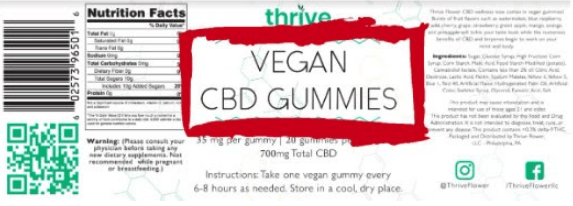
2. Ingredients
What goes into a CBD product must be listed on the packaging of a CBD product to comply with full transparency to the customer. This includes a clear declaration of the type of CBD extract in the product whether that be full-spectrum, broad-spectrum, isolate, or nano extracts.

3. Net Quantity and Potency
The total contents of the product need to be clear and easily understood by the customer. This includes total units in the product and total potency. For example, Thrive Flower’s CBD Drops come in a 30mL bottle and the serving size is 1mL so there are 30 servings per package. The total potency is either 750mg, 1500mg, or 3500mg.
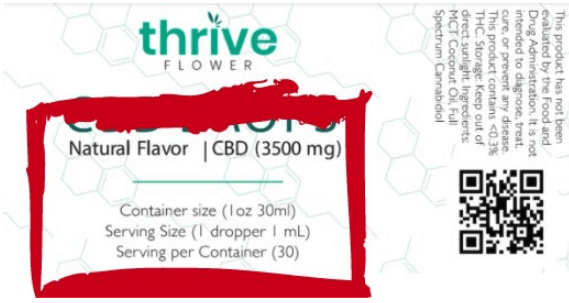
4. Suggested Use
Clear instructions should be present on the label to guide the customer through the product’s suggested use. This includes how to use the product, how much to take, how often to use it, and proper storage.
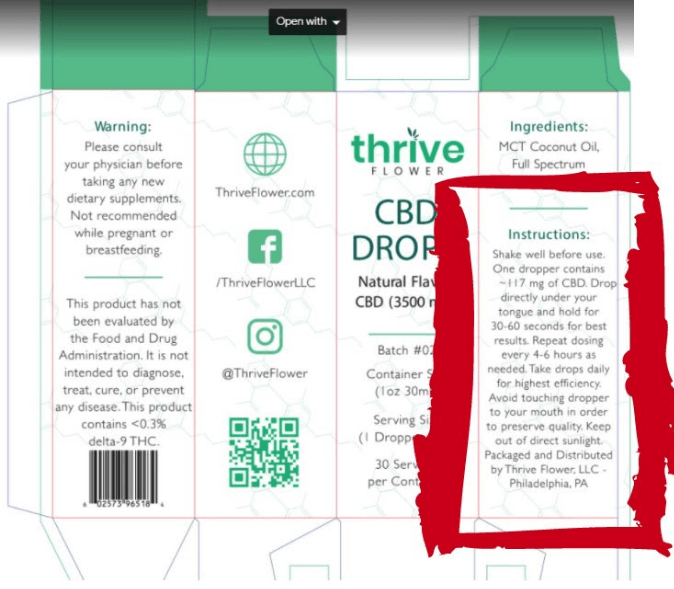
5. Batch Number
Having the batch number on a CBD product label is important because the testing of each product is supposed to be done by batch. Meaning, just because it is the same product, when you go to produce more, that new batch should be tested.
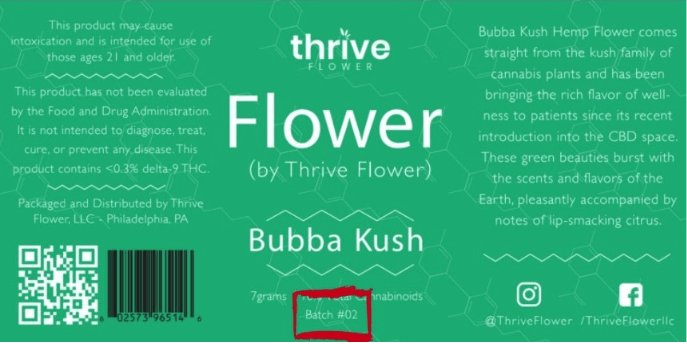
6. Distributor or Manufacturer Information
A reliable CBD company should not be hiding in the dark. The distributor or manufacturer’s name and place of business should be on the label. Say it loud and say it proud!

7. FDA and Other Warnings
It is important to make it clear that the FDA has not approved of any CBD products and that these products do not heal or treat any disease. Advising against pregnant and breastfeeding women is important as well. Legally, all CBD products must be derived from hemp and contain less than 0.3% delta-9 THC. That is definitely label worthy.
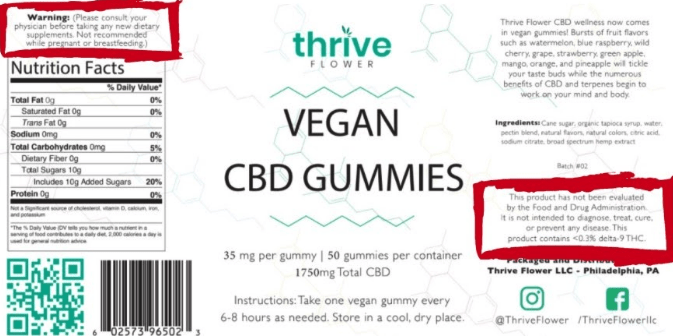
8. QR Code (optional)
Having a QR code on the label allows a customer to use their smartphone camera to scan the code and be directed to a website with more useful information. For Thrive Flower, the QR code leads to the lab test result’s page of the company website. Easily accessible and up-to-date lab results keep the customer as informed as possible about the product they are purchasing.
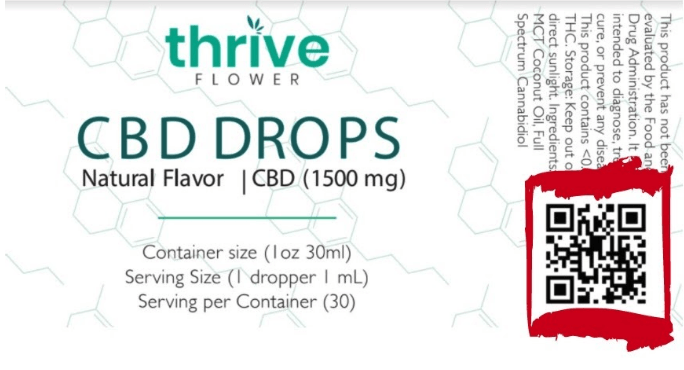
Why a CBD Product Label May Contain Inaccurate Information
Health Claims
The FDA does not mess around when it comes to health claims from CBD companies. Because the FDA has not approved of any CBD medications, no CBD product can claim to heal, treat, diagnose, or cure any disease. Doing so may get you a warning letter from the FDA. “Failure to correct the violations promptly may result in legal action, including product seizure and injunction” (FDA).
Not Testing by Batch
When a product is not tested by batch, there could be a change in the product’s potency or purity that might go unnoticed. It is the responsibility of a CBD company to do their due diligence and test each batch of product, not just the first round. Some companies choose not to do this because testing is not cheap. Each new batch also requires a new label that displays the updated batch number. These costs are what steer some companies away from batch-to-batch testing.
Not Testing a Product that is White or Private Labeled
Some CBD products are white or private labeled. This means that one company manufacturers the product, then another company purchases it in bulk and puts their own label on it to market it as their own. This is a very common practice. The manufacturer should have lab-tested results for the products they are selling, but that does not mean your company should fully trust them and not do your own testing.
It is unfortunate that it is not uncommon to find shady suppliers trying to push bunk products to companies who then do not test the products themselves. These products are then inaccurately labeled and the consumer does not get what they paid for. This can also endanger them if there is more than the legal limit of THC. Using the product could impair them and they could fail a drug test.
Lying About Test Results
It is a crying shame that a supposed wellness company would lie about what is in their CBD product. Intentionally misleading consumers to push products that otherwise have less CBD that advertised is morally wrong, yet some companies do it. One reason may be to keep costs down. Another may be because the product is over the legal delta-9 THC limit and they were too lazy or greedy to make it compliant.
Testing Variations
Because of the lack of regulation by the FDA in the CBD market, there is no standardized process for testing for a product’s potency, presence of heavy metals and pesticides, etc. The same product, tested at two different labs, may yield different results. Variance can be up to 40% in some cases.
Each lab has different protocols for their testing procedure and this lack of standardization is an issue for the cannabis market. Another issue with testing is the homogeneity of the product. Is the CBD equally and evenly distributed throughout the whole product? What about throughout the entire batch? If not, it could be possible that two gummies in the same jar could contain differing levels of CBD. When testing products, it is best to average the results of several samples randomly chosen from the batch.




